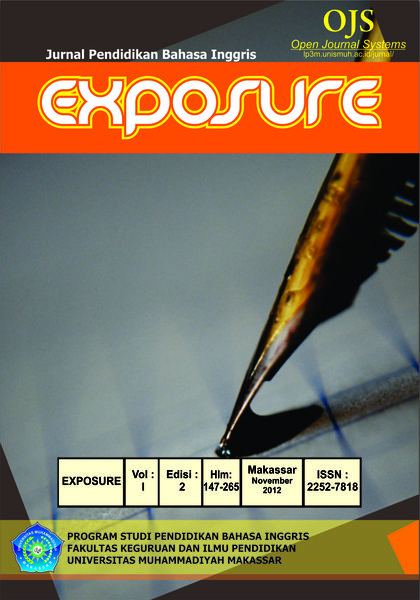USING ECLECTIC APPROACH TO IMPROVE THE STUDENTS’ READING COMPREHENSION
DOI:
https://doi.org/10.26618/exposure.v1i2.776Abstract
The research aimed to find out the improvement of students’ reading comprehension in terms of finding main ideas and meaning of words at the students’ of SMPN 4 Libureng in the 2012/2013 academic year. This research used A Classroom Action Research that consisted two cycles. The sample of this research consisted of 22 students, those consisted of six women and twelve men.The researcher obtained the data by using reading test and observation sheet. The results of the student's reading test in cycle I and cycle II had significantly different scores. There was a better increase of gains by students at the end of the action in the second cycle. In the cycle, I, the students’ achievement of main ideas was 6,09, but after evaluation in cycle II, the students’ reading comprehension become 7,62.The other hand the students’ meaning of words was improved too from cycle I to cycle II, whereas in the students’ achievement of the meaning of words was 6,13, but after evaluation in cycle II, the students’ achievement becomes 7,74. From the findings indicated that there was the improvement in the students’ reading comprehension from cycle I to cycle II, whereas in cycle I students’ achievement reading comprehension was 23,81, but after evaluating in cycle II the students’ reading comprehension became 25,69. While the standard target achievement KKM 66. From these findings, the researcher made the conclusion that by using an eclectic approach could improve the students’ reading comprehension achievement.
Key Word: Eclectic Approach, Improve, Reading Comprehension
References
Alexander, eastill j. 1997. Teaching reading USA: Litle, Brown and company.
Allyn & Bacon, 2010. Factors affect reading comprehension. Accessed to http://www.Learningpt.org/literacy/activitypdfs/comprehension.Pdf. download at June 13, 2010.
Arikunto, Suharsimi, 2006. Procedure penelitian suatu pendekatan praktek. Jakarta: Rineka cipta.
Arikunto, Suharsimi, suhardjono, supardi, 2008. Penelitian tindakan kelas. Jakarta PT. Bumi Aksarah.
Band and Dykstrain, 1979 teaching reading comprehension by using an eclectic approach.
Farris, Pamela j. Fuhler, carol j. Walther, Maria P, 2004. Teaching reading: balanced Approach for today‘s classroom. New York: the Mc Graw. Hill Companies, Inc.
Gay, Ir. 1981. Education competencies for analysis and application. New York: Oxford University Press.
Kikuci, 2008. Improving the reading comprehension by using close caption can motivate Students to learn English especially in reading allot in movies.
Lenz Keith, 2008. Factors affect reading comprehension. Accessed to http://www. Learning
pt.org/literacy/activitypdps/comprehension.pdf.dowload at June 13, 2010.
Mautner, 2000. An eclectic approach Accessed to http://www.mb.comph/articles/teaching-method-eclectic download at
june, 13, 2010.Mccormick, 1988. The article of language experience approach. Accessed to http://primary-school curriculum. Suite 101. Com-article language experience approach. Download at June 13, 2010.
Perrone, Vito, 1994. Basal reader. Accessed too copyright 1994 by Chelsea house Publisher. Download at July 2009.
Ruth manimtim-florescar, 2008. What is the eclectic approach? Accessed to http://www.mb.com/ph/articles/teaching-method-eclectic download on June, 13, 2010.
Rivers, 1981. The main proponent of the eclectic approach allows language teacher.
Stren, 1983. Memorandum on the teaching of modern language. The USA incorporate Association of assistant masters in secondary school.
Tomkins, 2006. Implementation the language experience approach.
Vacca, 2006. A great example of this approach is story dictation. Students are able to create lessons using their own language.
Vaproyeen, Nancy, Clouse, R. Wilbourn, 1994. Three approaches to reading: basal Language, and computer-assisted instruction. Accessed to educational Resources information center (ERIC) download at June 13, 2010.
Downloads
Published
Issue
Section
License
Authors who publish with this journal agree to the following terms:
In order to assure the highest standards for published articles, a peer review policy is applied. In pursue of the compliance with academic standards, all parties involved in the publishing process (the authors, the editors and the editorial board and the reviewers) agree to meet the responsibilities stated below in accordance to the Journal publication ethics and malpractice statement.
Duties of Authors:
- The author(s) warrant that the submitted article is an original work, which has not been previously published, and that they have obtained an agreement from any co-author(s) prior to the manuscript’s submission;
- The author(s) should not submit articles describing essentially the same research to more than one journal;
- The authors(s) make certain that the manuscript meets the terms of the Manuscript Submission Guideline regarding appropriate academic citation and that no copyright infringement occurs;
- The authors(s) should inform the editors about any conflict of interests and report any errors they subsequently, discover in their manuscript.
Duties of Editors and the Editorial Board:
- The editors, together with the editorial board, are responsible for deciding upon the publication or rejection of the submitted manuscripts based only on their originality, significance, and relevance to the domains of the journal;
- The editors evaluate the manuscripts compliance with academic criteria, the domains of the journal and the guidelines;
- The editors must at all times respect the confidentiality of any information pertaining to the submitted manuscripts;
- The editors assign the review of each manuscript to two reviewers chosen according to their domains of expertise. The editors must take into account any conflict of interest reported by the authors and the reviewers.
- The editors must ensure that the comments and recommendations of the reviewers are sent to the author(s) in due time and that the manuscripts are returned to the editors, who take the final decision to publish them or not.
Authors are permitted and encouraged to post online a pre-publication manuscript (but not the Publisher’s final formatted PDF version of the Work) in institutional repositories or on their Websites prior to and during the submission process, as it can lead to productive exchanges, as well as earlier and greater citation of published work (see The Effect of Open Access). Any such posting made before acceptance and publication of the Work shall be updated upon publication to include a reference to the Publisher-assigned DOI (Digital Object Identifier) and a link to the online abstract for the final published Work in the Journal.

